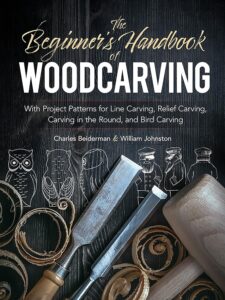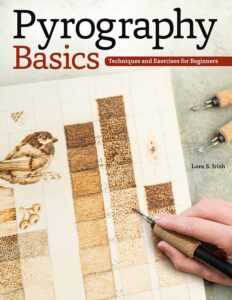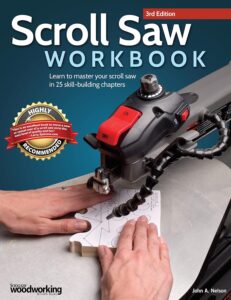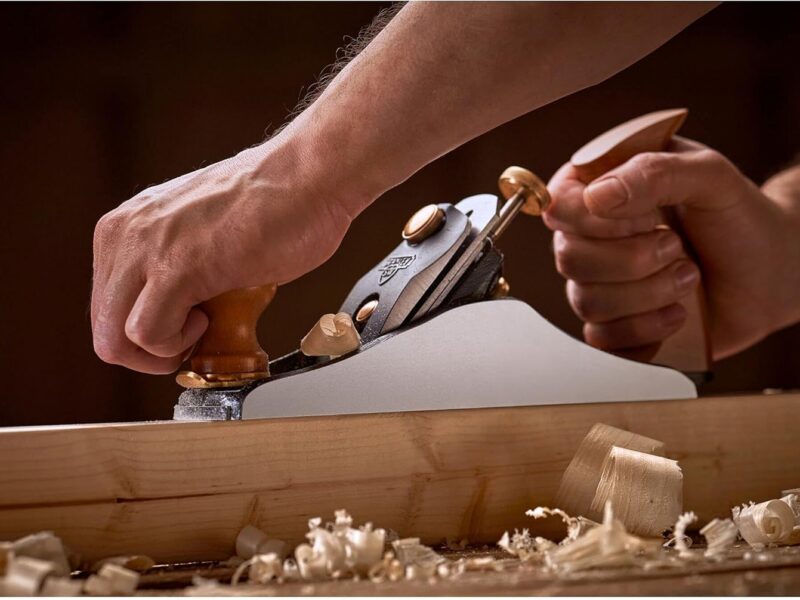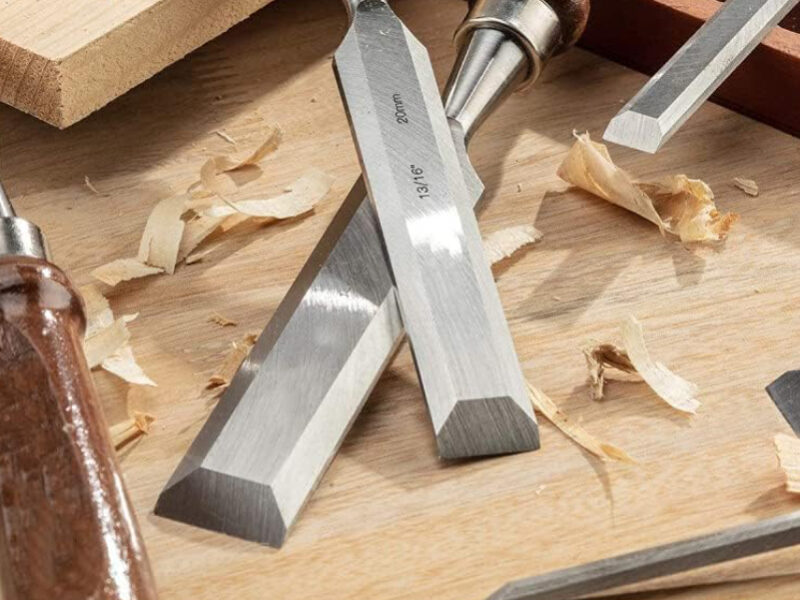Living in an apartment or other small space doesn’t mean you can’t enjoy woodworking as a hobby, or even a money-making side hustle. OK, you’re not going to be doing a lot of cabinetmaking, and in fact most (but not all) power tools are going to be out. Nevertheless, there are plenty of fascinating projects that are perfectly practical. So here we go with the definitive guide to how to do woodworking in an apartment!
The Main Considerations For Apartment Woodworking
- Neighbors: Whether you get on well with the folks next door or across the hall you don’t want to be making lots of noise with your woodworking. It’s just going to get you in trouble you don’t need. Quiet woodworking? Yep, we can do that.
- Storage: Tools need to be kept a modest size, and because you probably don’t have space to leave them out all the time they need to be easy to put away. Look for compact storage solutions like small, stacking boxes or hanging organizers.
- Workbench: Having a dedicated apartment workbench is unlikely to be practical, so we need woodworking projects that can be carried out on the kitchen worktop or dining table.
 Materials and Waste: There isn’t space to be carting around and cutting up 8×4 sheets of plywood! We need to keep raw materials to manageable sizes. Also, woodworking creates dust so it’s essential to clean up thoroughly after each session. A standard vacuum cleaner can work but sawdust is notorious for clogging filters. You might eventually want to consider a dedicated machine like the compact Shop-Vac .
Materials and Waste: There isn’t space to be carting around and cutting up 8×4 sheets of plywood! We need to keep raw materials to manageable sizes. Also, woodworking creates dust so it’s essential to clean up thoroughly after each session. A standard vacuum cleaner can work but sawdust is notorious for clogging filters. You might eventually want to consider a dedicated machine like the compact Shop-Vac .- Ventilation: Proper ventilation is vital for apartment woodworking, especially when using finishes or stains. Some can give off really unpleasant odors. Open a window or use a small fan to circulate air — but position it carefully. You don’t want to be bloing dust everywhere!
- Personal protection: You might only be woodworking in a small space but don’t forget the basics of personal safety. Always wear eye protection and a dust mask.
Woodwork In An Apartment – Three Creative Choices
-
 Whittling and Carving: These crafts require minimal space and tools. You tend to create small wood chips rather than fine sawdust so it’s easy to clean up. You can start whittling with nothing more than a basic penknife and a stick. Wood carving generally uses a few more tools, and you can create intricate designs or functional pieces like spoons and letter openers. Carvings can be stained or painted, so there’s no limit on the art you can create.
Whittling and Carving: These crafts require minimal space and tools. You tend to create small wood chips rather than fine sawdust so it’s easy to clean up. You can start whittling with nothing more than a basic penknife and a stick. Wood carving generally uses a few more tools, and you can create intricate designs or functional pieces like spoons and letter openers. Carvings can be stained or painted, so there’s no limit on the art you can create. - Pyrography: Also known as wood burning, this technique uses a heated pen to create designs on wood. It’s a quiet and clean craft ideal for apartments. You can start with simple wood blanks, but pyrography can be applied to other organic surfaces like leather, paper maché, and canvas. The variety of useful or decorative items you can create is almost limitless.
 Scrollsawing: This is an easy craft for beginners to learn and it soon becomes absorbing. As your skills improve it’s possible to create remarkably intricate patterns. Cutting jigsaws is popular, but people also make wall hangings, mobiles, and interlinked models. A scrollsaw is a relatively quiet tool, and safe enough for children to learn under supervision. They do create some dust, but it’s not a great deal and shouldn’t spread far from the tool.
Scrollsawing: This is an easy craft for beginners to learn and it soon becomes absorbing. As your skills improve it’s possible to create remarkably intricate patterns. Cutting jigsaws is popular, but people also make wall hangings, mobiles, and interlinked models. A scrollsaw is a relatively quiet tool, and safe enough for children to learn under supervision. They do create some dust, but it’s not a great deal and shouldn’t spread far from the tool.- Intarsia: This art form involves creating pictures or designs by assembling small pieces of wood. Pieces are usually cut using a scrollsaw. However, it can involve quite a lot of sanding so it’s a little more messy than other apartment woodworking.
What Tools Will You Need For Apartment Woodworking?
Whittling and Carving
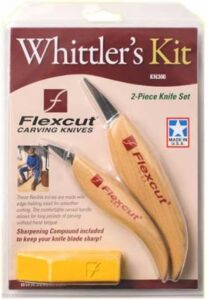 If you already own a penknife you’re good to go with starting to whittle, or you can pick one up for very little money from the local hardware store. Eventually, you might want to invest in something that will provide a little more precision. When it comes to edge tools it’s tough to beat Flexcut, which are made in the US. Their Whittler’s Kit has 2 knives and sharpening compound to keep the edges keen. It’s currently $46.98.
If you already own a penknife you’re good to go with starting to whittle, or you can pick one up for very little money from the local hardware store. Eventually, you might want to invest in something that will provide a little more precision. When it comes to edge tools it’s tough to beat Flexcut, which are made in the US. Their Whittler’s Kit has 2 knives and sharpening compound to keep the edges keen. It’s currently $46.98.
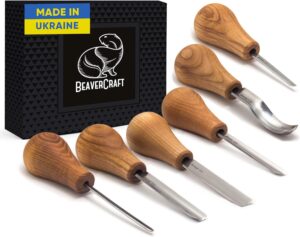 I guess you could look at carving as a more advanced kind of whittling. Carving tools come in a huge variety of shapes and sizes and can be expensive. However, it’s a mistake to buy cheap carving tools because it’s almost impossible to keep them sharp. Flexcut make a lot of very fine carving chisels, but they might be beyond the budget of a lot of beginners. As a starter set I like the woodcarving chisel set from Beavercraft that includes 6 versatile chisels in a nice protective box for $74.99. You might also want to invest in a carving glove. It could save you from a nasty injury and costs less than 15 bucks.
I guess you could look at carving as a more advanced kind of whittling. Carving tools come in a huge variety of shapes and sizes and can be expensive. However, it’s a mistake to buy cheap carving tools because it’s almost impossible to keep them sharp. Flexcut make a lot of very fine carving chisels, but they might be beyond the budget of a lot of beginners. As a starter set I like the woodcarving chisel set from Beavercraft that includes 6 versatile chisels in a nice protective box for $74.99. You might also want to invest in a carving glove. It could save you from a nasty injury and costs less than 15 bucks.
Pyrography
I’ve actually done pyrography with a basic soldering iron that cost just a few bucks. It works if you don’t mind something basic but it’s not very accurate and you can only draw fat dots and thick lines.
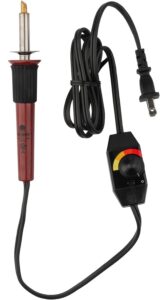 Proper pyrography pens (or woodburning pens) come in two basic types: solid tip or wire tip. Both should have adjustable temperature which is important for working on different materials and for changing the darkness of the mark you make. I’ve chosen a couple of models from leading brand Walnut Hollow that illustrate the main differences.
Proper pyrography pens (or woodburning pens) come in two basic types: solid tip or wire tip. Both should have adjustable temperature which is important for working on different materials and for changing the darkness of the mark you make. I’ve chosen a couple of models from leading brand Walnut Hollow that illustrate the main differences.
The Versa Tool comes with 11 interchangeable points allowing you to make a wide variety of marks. There’s a wire stand to keep the hot end off the worktop or table. This pyrography pen is currently $25.12.
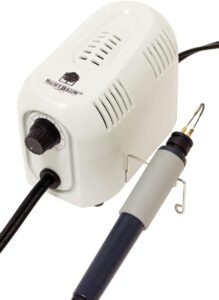 The Creative Woodburner Wire Tool comes with 4 points but others can be added and many pyrographers make their own custom points as they get more experience. Wire pyrography tools tend to offer more control and precision, though they are a bit more expensive. This one is $65.94.
The Creative Woodburner Wire Tool comes with 4 points but others can be added and many pyrographers make their own custom points as they get more experience. Wire pyrography tools tend to offer more control and precision, though they are a bit more expensive. This one is $65.94.
Scrollsawing
So pretty obviously the key bit of kit here is a scrollsaw! Mine comes from English company Record Power and I’ve had it for about fifteen years. It still hums away happily. Unfortunately it’s 240 volts so I have to run it off a transformer which is a bit inconvenient.
 If I was buying one now I would look at a couple of alternatives. At the budget end of the market, the WEN scrollsaw gets a lot of positive feedback and costs just $119.00. It’s plenty big enough for all kinds of scrollsaw projects and cuts wood up to 2 inches thick. You can buy smaller scrollsaws, and you might want to check the overall dimensions if your workspace is tight. I like a 16-inch model because it places few restrictions on the size of scrollsaw project you can tackle.
If I was buying one now I would look at a couple of alternatives. At the budget end of the market, the WEN scrollsaw gets a lot of positive feedback and costs just $119.00. It’s plenty big enough for all kinds of scrollsaw projects and cuts wood up to 2 inches thick. You can buy smaller scrollsaws, and you might want to check the overall dimensions if your workspace is tight. I like a 16-inch model because it places few restrictions on the size of scrollsaw project you can tackle.
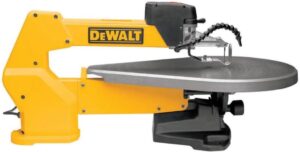 At the other end of the scale is the DeWalt 20-inch scrollsaw that costs $599.00. I know, it’s a lot of money but what can I tell you? It’s an outstanding, pro-grade tool widely recognized as one of the best available. It’s also pretty big and heavy which damps out vibration and makes it possible to be very accurate. It might be beyond what you’ve got space for though.
At the other end of the scale is the DeWalt 20-inch scrollsaw that costs $599.00. I know, it’s a lot of money but what can I tell you? It’s an outstanding, pro-grade tool widely recognized as one of the best available. It’s also pretty big and heavy which damps out vibration and makes it possible to be very accurate. It might be beyond what you’ve got space for though.
Recommended Books for Apartment Woodworking
So how do you learn your new craft? There are hundreds of videos on YouTube about any of these projects and they can be a fun watch. Personally, I prefer a good book. It’s something that you can keep beside you on the table for quick and easy reference. Judging by the feedback on Amazon the following are all extremely popular.
Whittling and Carving
Pyrography
I hope you’ve enjoyed my exploration of how to do woodworking in an apartment and that something here inspires you to try a new craft. They are a great way to relax and de-stress. If you have any questions or comments drop me a line here.
Main photo by Samantha Hurley.


